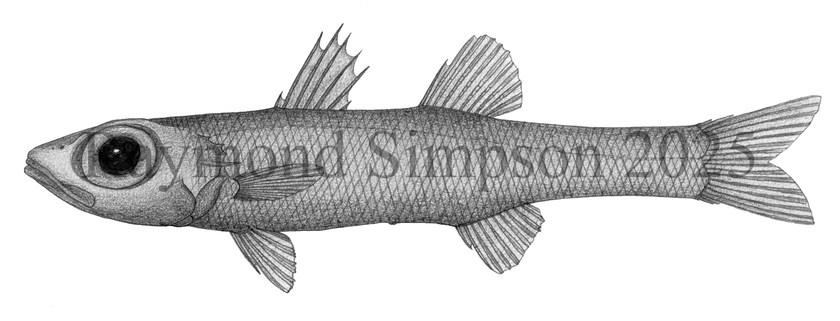
Common Name
Western Deepsea Cardinalfish
Year Described
Goode & Bean, 1896
Identification
Dorsal Fin: VII-I, 10
Anal Fin: II, 9 (rarely 8)
Pectoral Fin: 19-21
Lateral Line: 46-51
Gill Rakers: 23-26 (first arch)
Vertebrae: 10+15 = 25 total
Body very slender and laterally compressed. Body depth 14-20% SL. Large terminal mouth. Teeth conical. Lingual and endopterygoid teeth absent. No enlarged teeth present at lower jaw symphysis. Maxillary process absent. Opercular spine present. Other spinelets present under main spine. Pyloric caeca 8-10. No ribs on last abdominal vertebrae. First dorsal spine tiny. Lateral line complete and composed of pored scales. No luminous organ on belly.
Color
Body overall very dark. Opercle, flanks and belly silvery. Fin membranes dark. Eyes and gill region black. Inside of mouth variable (darkens with size). Young can show a caudal peduncle ring.
Size
Maximum size to 179mm SL.
Habitat
Occurs near hard bottoms and walls from 360-735m but usually 500-550m.
Range
Nova Scotia (offshore Gulf Stream) to Florida and S. Brazil, including the Gulf of Mexico and Caribbean Sea.
References
Mayer, G. F. 1974. A revision of the cardinalfish genus Epigonus (Perciformes, Apogonidae), with descriptions of two new species. Bulletin of the Museum of Comparative Zoology v. 146 (no. 3): 147-203.
Okamoto, M. 2012. Two new species of the genus Epigonus (Perciformes: Epigonidae) from the South Pacific, with a definition of the Epigonus constanciae group. Ichthyological Research, 59, 242-254.
Okamoto, M. 2016. Validity of Epigonus megalops (Perciformes: Epigonidae), redescription of E. atherinoides, and first record of E. draco from the central South Pacific. Species Diversity, 21(2), 177-186.
Other Notes
Epigonus occidentalis, E. pectinifer, and E. robustus are the only Epigonus in the area with strong opercular spines (the E. constanciae group). The very slender body, low gill raker count, and opercular spine separate this from all other members of the genus.